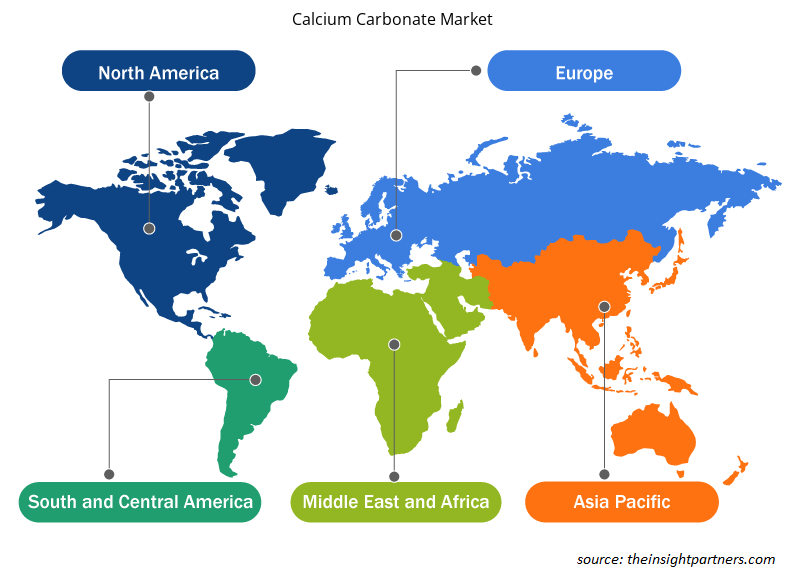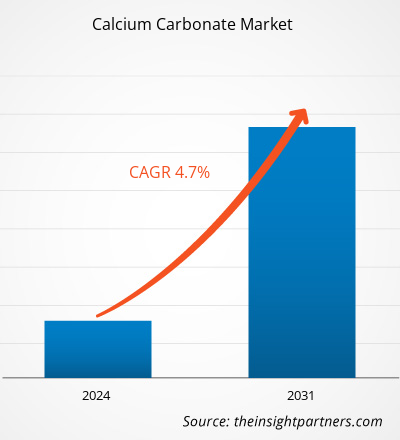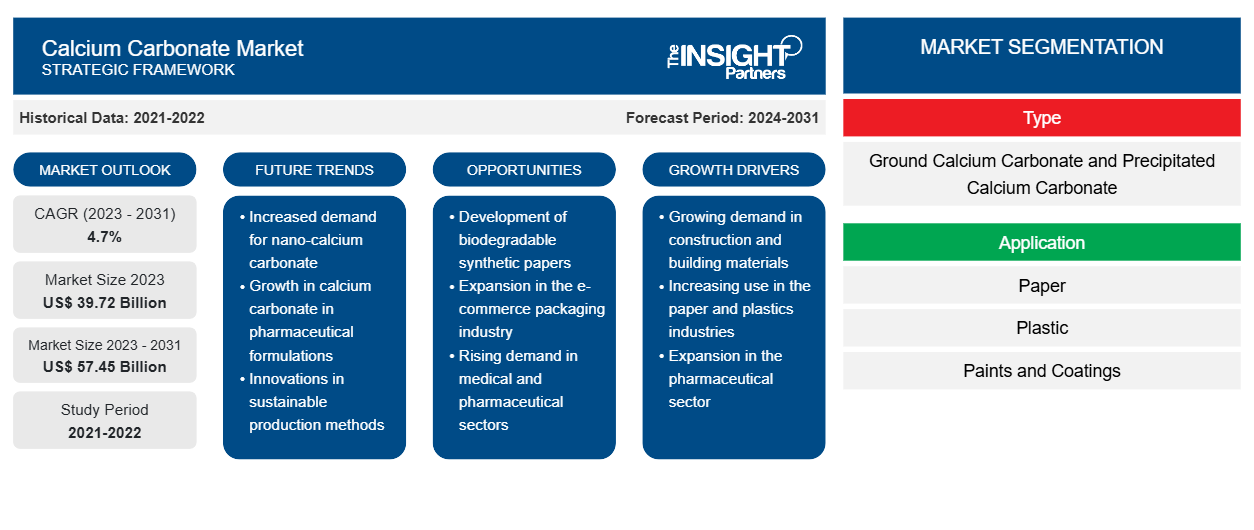Der Markt für Calciumcarbonat soll von 39,72 Milliarden US-Dollar im Jahr 2023 auf 57,45 Milliarden US-Dollar im Jahr 2031 anwachsen. Der Markt soll zwischen 2023 und 2031 eine durchschnittliche jährliche Wachstumsrate (CAGR) von 4,7 % verzeichnen. Die steigende Nachfrage nach Mikro- und Nanopartikeln von Calciumcarbonat dürfte ein wichtiger Trend auf dem Calciumcarbonat-Markt bleiben.
Calciumcarbonat Marktanalyse
Die hohe Nachfrage nach Calciumcarbonat als Kunststofffüllstoff treibt das Marktwachstum vor allem voran. Calciumcarbonat wird in der Kunststoffindustrie häufig als Kunststofffüllstoff verwendet , normalerweise in Form von weißem Granulat. Kunststofffüllstoff, der hauptsächlich aus Calciumcarbonat und Basisharz besteht, wird bevorzugt, da Calciumcarbonat reichlich vorhanden und leicht erhältlich ist. Außerdem verbessert es die physikalischen Eigenschaften von Kunststoff. Darüber hinaus ist Calciumcarbonat nicht umweltschädlich.
Calciumcarbonat Marktübersicht
Calciumcarbonat ist eine chemische Verbindung mit der Molekülformel CaCO3, die aus Calcium, Kohlenstoff und Sauerstoff besteht. Es kommt in der Natur häufig als Mineral vor und ist der Hauptbestandteil verschiedener Gesteine wie Kalkstein, Marmor und Kreide. Aufgrund seiner vielseitigen Eigenschaften wird Calciumcarbonat in verschiedenen Branchen und Anwendungen häufig verwendet. Es ist ein weißes, geruchloses Pulver, das in Wasser unlöslich, aber in Säuren löslich ist. Es dient als Nahrungsergänzungsmittel für Calcium und wird als Füllstoff oder Pigment bei der Herstellung von Papier, Kunststoffen, Farben und Beschichtungen verwendet. Darüber hinaus wird es hauptsächlich bei der Herstellung von Zement und Keramik eingesetzt.
Passen Sie diesen Bericht Ihren Anforderungen an
Sie erhalten kostenlos individuelle Anpassungen an jedem Bericht, einschließlich Teilen dieses Berichts oder einer Analyse auf Länderebene, eines Excel-Datenpakets sowie tolle Angebote und Rabatte für Start-ups und Universitäten.
-
Holen Sie sich die wichtigsten Markttrends aus diesem Bericht.Dieses KOSTENLOSE Beispiel umfasst eine Datenanalyse von Markttrends bis hin zu Schätzungen und Prognosen.
Calciumcarbonat-Markttreiber und -Chancen
Hohe Nachfrage nach Calciumcarbonat aus der Papierindustrie
Die anhaltende Nachfrage aus der Papierindustrie spielt eine entscheidende Rolle für das Wachstum des Calciumcarbonat-Marktes. Calciumcarbonat wird in großem Umfang als Füllstoff und Beschichtungspigment bei der Herstellung von Papier- und Kartonprodukten verwendet. Es verbessert die Helligkeit, Opazität und Glätte des Papiers und verbessert so seine Bedruckbarkeit und Gesamtqualität. Da die Papierindustrie aufgrund von Faktoren wie Bevölkerungswachstum, Urbanisierung und der Nachfrage nach Verpackungsmaterialien weiterhin weltweit ein stetiges Wachstum verzeichnet, bleibt die Nachfrage nach Calciumcarbonat als Schlüsselrohstoff konstant hoch.
Starkes Wachstum in der Baubranche
Calciumcarbonat wird bei der Herstellung von Zement und Beton verwendet. Es findet auch Anwendung bei der Herstellung von Asphalt und im Straßenbau. Der Industriebausektor erlebt aufgrund mehrerer Faktoren ein schnelles Wachstum, wie etwa der zunehmenden Errichtung neuer Fabriken und Industrieanlagen, steigender Investitionen und staatlicher Initiativen. In den USA ist der Industriebau ein wesentlicher Teil der Wirtschaft des Landes. Dieser Sektor ist seit langem ein Motor des Wirtschaftswachstums in den USA. Die wachsenden Industriebauaktivitäten in verschiedenen Ländern auf der ganzen Welt treiben das Wachstum des Calciumcarbonat-Marktes voran.
Segmentierungsanalyse des Calciumcarbonat-Marktberichts
Schlüsselsegmente, die zur Ableitung der Calciumcarbonat-Marktanalyse beigetragen haben, sind Typ und Anwendung.
- Basierend auf dem Typ ist der Calciumcarbonatmarkt in gemahlenes Calciumcarbonat und gefälltes Calciumcarbonat segmentiert. Das Segment gemahlenes Calciumcarbonat hatte im Jahr 2023 einen bedeutenden Marktanteil.
- Nach Anwendung ist der Markt in Papier, Kunststoff, Farben und Beschichtungen, Klebstoffe und Dichtstoffe, Bauwesen und andere unterteilt. Das Papiersegment hielt im Jahr 2023 einen erheblichen Marktanteil.
Calciumcarbonat Marktanteilsanalyse nach Geografie
Der geografische Umfang des Calciumcarbonat-Marktberichts ist hauptsächlich in fünf Regionen unterteilt: Nordamerika, Asien-Pazifik, Europa, Naher Osten und Afrika sowie Süd- und Mittelamerika.
Die Region Nordamerika hält einen bedeutenden Anteil am Weltmarkt. In Nordamerika hat die steigende Nachfrage nach nachhaltigen und umweltfreundlichen Materialien den Markt für Calciumcarbonat angekurbelt, insbesondere in Anwendungen wie Papier, Kunststoffen und Beschichtungen. In Europa haben strenge Umweltschutzbestimmungen und eine starke Betonung der Nachhaltigkeit die Nachfrage nach Calciumcarbonat als bevorzugte Alternative zu anderen mineralischen Füllstoffen angekurbelt. Im asiatisch-pazifischen Raum haben die schnelle Industrialisierung, Urbanisierung und das Bevölkerungswachstum die Nachfrage nach Baumaterialien, Kunststoffen und Papierprodukten angeheizt und so zum Marktwachstum von Calciumcarbonat beigetragen.
Regionale Einblicke in den Calciumcarbonat-Markt
Die regionalen Trends und Faktoren, die den Calciumcarbonat-Markt im Prognosezeitraum beeinflussen, wurden von den Analysten von Insight Partners ausführlich erläutert. In diesem Abschnitt werden auch die Calciumcarbonat-Marktsegmente und die geografische Lage in Nordamerika, Europa, im asiatisch-pazifischen Raum, im Nahen Osten und Afrika sowie in Süd- und Mittelamerika erörtert.

- Erhalten Sie regionale Daten zum Calciumcarbonat-Markt
Umfang des Calciumcarbonat-Marktberichts
| Berichtsattribut | Details |
|---|---|
| Marktgröße im Jahr 2023 | 39,72 Milliarden US-Dollar |
| Marktgröße bis 2031 | 57,45 Milliarden US-Dollar |
| Globale CAGR (2023 - 2031) | 4,7 % |
| Historische Daten | 2021-2022 |
| Prognosezeitraum | 2024–2031 |
| Abgedeckte Segmente |
Nach Typ
|
| Abgedeckte Regionen und Länder |
Nordamerika
|
| Marktführer und wichtige Unternehmensprofile |
|
Dichte der Akteure auf dem Calciumcarbonat-Markt: Auswirkungen auf die Geschäftsdynamik verstehen
Der Markt für Calciumcarbonat wächst rasant, angetrieben durch die steigende Nachfrage der Endverbraucher aufgrund von Faktoren wie sich entwickelnden Verbraucherpräferenzen, technologischen Fortschritten und einem größeren Bewusstsein für die Vorteile des Produkts. Mit steigender Nachfrage erweitern Unternehmen ihr Angebot, entwickeln Innovationen, um die Bedürfnisse der Verbraucher zu erfüllen, und nutzen neue Trends, was das Marktwachstum weiter ankurbelt.
Die Marktteilnehmerdichte bezieht sich auf die Verteilung von Firmen oder Unternehmen, die in einem bestimmten Markt oder einer bestimmten Branche tätig sind. Sie gibt an, wie viele Wettbewerber (Marktteilnehmer) in einem bestimmten Marktraum im Verhältnis zu seiner Größe oder seinem gesamten Marktwert präsent sind.
Die wichtigsten auf dem Calciumcarbonat-Markt tätigen Unternehmen sind:
- Cerne Calcium Unternehmen
- GCCP Resources LTD
- JM Huber Corporation
- Imerys SA
- Lafargeholcim
- Minerals Technologies Inc.
Haftungsausschluss : Die oben aufgeführten Unternehmen sind nicht in einer bestimmten Reihenfolge aufgeführt.

- Überblick über die wichtigsten Akteure auf dem Calciumcarbonat-Markt
Neuigkeiten und aktuelle Entwicklungen zum Calciumcarbonat-Markt
Der Calciumcarbonat-Markt wird durch die Erhebung qualitativer und quantitativer Daten nach Primär- und Sekundärforschung bewertet, die wichtige Unternehmensveröffentlichungen, Verbandsdaten und Datenbanken umfasst. Im Folgenden finden Sie eine Liste der Entwicklungen auf dem Calciumcarbonat-Markt und der Strategien:
- Cimbar Resources, Inc. gab heute bekannt, dass es die Übernahme der Produktionsanlagen für Calciumcarbonate in Sahuarita, AZ, von Imerys Carbonates, USA Inc. abgeschlossen hat. (Quelle: CIMBAR RESOURCES, INC., Unternehmenswebsite/News/2022)
- Imerys gibt heute neue Investitionen zur Kapazitätserweiterung und -optimierung im Werk Sylacauga (AL) bekannt, dem größten Standort der Gruppe in Nordamerika. Diese Investition ist Teil eines dreijährigen Standortplans zur Unterstützung der wachsenden Nachfrage nach gemahlenen Calciumcarbonatprodukten und zugleich Teil des Engagements von Imerys, sein Geschäft in den Gemeinden und Regionen, in denen es tätig ist, auszubauen. (Quelle: Imerys, Unternehmenswebsite/Medienraum/Pressemitteilung/2022)
Calciumcarbonat-Marktbericht – Umfang und Ergebnisse
Der Bericht „Calciumcarbonat-Marktgröße und -prognose (2021–2031)“ bietet eine detaillierte Analyse des Marktes, die die folgenden Bereiche abdeckt:
- Marktgröße und Prognose auf globaler, regionaler und Länderebene für alle wichtigen Marktsegmente, die im Rahmen des Projekts abgedeckt sind
- Marktdynamik wie Treiber, Beschränkungen und wichtige Chancen
- Wichtige Zukunftstrends
- Detaillierte Porter's Five Forces und SWOT-Analyse
- Globale und regionale Marktanalyse mit wichtigen Markttrends, wichtigen Akteuren, Vorschriften und aktuellen Marktentwicklungen
- Branchenlandschaft und Wettbewerbsanalyse, einschließlich Marktkonzentration, Heatmap-Analyse, prominenten Akteuren und aktuellen Entwicklungen
- Detaillierte Firmenprofile
- Historische Analyse (2 Jahre), Basisjahr, Prognose (7 Jahre) mit CAGR
- PEST- und SWOT-Analyse
- Marktgröße Wert/Volumen – Global, Regional, Land
- Branchen- und Wettbewerbslandschaft
- Excel-Datensatz
Aktuelle Berichte
Erfahrungsberichte
Grund zum Kauf
- Fundierte Entscheidungsfindung
- Marktdynamik verstehen
- Wettbewerbsanalyse
- Kundeneinblicke
- Marktprognosen
- Risikominimierung
- Strategische Planung
- Investitionsbegründung
- Identifizierung neuer Märkte
- Verbesserung von Marketingstrategien
- Steigerung der Betriebseffizienz
- Anpassung an regulatorische Trends























 Kostenlose Probe anfordern für - Calciumcarbonat-Markt
Kostenlose Probe anfordern für - Calciumcarbonat-Markt